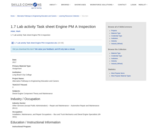
Automotive preventive maintenance inspection worksheet.
- Subject:
- Automotive Technology and Repair
- Career and Technical Education
- Material Type:
- Homework/Assignment
- Provider:
- Skills Commons
- Author:
- Mark Adair
- Date Added:
- 08/17/2022

Automotive preventive maintenance inspection worksheet.
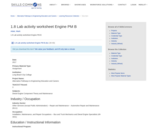
Automotive preventive maintenance inspection worksheet.

This activity guides students through the evaluation of a website that they have created to see if it is accessible for users with disabilities. Students will simulate a number of different disabilities (e.g. visual impairments, color blindness, auditory impairments, motor impairments) to see if their website is accessible; they will also use automated W3 and WAVE tools to evaluate their sites. Students will consider the needs of users with disabilities by creating a persona and scenario of a user with disabilities interacting with their site. Finally, students will write up recommendations to change their site and implement the changes.
Comments
Although this activity can be used in isolation, it is intended to be part of a series guiding students towards the creation of a front-end of a website. The series (all published as OER) consist of:
a) Needfinding
b) Personas, Scenarios and Storyboards
c) Front-end Website Design and Development
d) Accessibility Evaluation
![Air Pollution [Liberal Arts: Math and Science/Natural Science]](https://vivaopen.oercommons.org/static/newdesign/images/materials/default-thumbnail-index.png)
This assignment was designed for students in the pathways introductory chemistry class and the first year seminar and aligns with the Inquiry and Problem Solving core competency. In this context, there is a focus on framing the issues (identifies and/or addresses questions and problems), evidence gathering (assembles, reviews and synthesizes evidence from several diverse sources), evidence (analyze the data to address the questions posed) and conclusions (critical thinking, reflect on the outcomes, draw conclusions and generate new knowledge). There is also a Global Learning component based on comparing data collected locally with corresponding data from other locations or countries. The assignment includes the written communication ability with a focus on "Content Development and Organization," as well as the clarity of the communication and its purpose. The overall aim of this assignment is to enhance students' conceptual learning and understanding of key issues related to society as well as their course. This assignment was developed as part of a LaGuardia Global Learning mini-grant and CUNY Experiential Learning and Research in the Classroom mini-grants.
The assignment will be scaffolded over about 3 weeks and is worth about 10% of the final grade.
To further increase the success of this assignment, instructors might want to consider the following: Use class discussions to focus on the relevance and importance of conceptual learning. In order to improve the data analysis aspect, incorporating class demonstrations of how to conduct the analysis and guide discussions about what the data means. Giving students more detailed rubrics with formal expectations of the requirements of the assignments, particularly in the written format Find ways to increase student participation in class discussions.
When this assignment has been utilized in previous semesters, students clearly displayed the capability to relate the co-curricular experiences in the data collection and its analysis to concepts and ideas covered during class. Evidence for this came from very dynamic and interactive class discussions based on air pollution as well as from the output of the written assignment, in which students were able to relate the nature, sources and chemical properties of the pollutants to their impact on the environment, health and society in general.
LaGuardia's Core Competencies and Communication Abilities
List the Program Goal(s) that this assignment targets
Global Learning based on comparing pollutant levels around the LaGuardia campus with those in other locations or countries. It is also an IPS assignment, incorporating scientific literacy and thinking, as students need to analyze the data, interpret it and reflect on the outcomes.
List the Student Learning Objective(s) that this assignment targets
Identify and apply fundamental chemical concepts and methods. Gather, analyze, and interpret data.
List the Course Objectives(s) that this assignment targets
Explore the complex connections between chemistry and society. Apply chemical principles to real world issues, including ethical aspects. Gather, analyze, and interpret data.
Write a short description of the pedagogy involved in executing this assignment
Students collect and analyze the data, interpret the results in terms of pollution levels, safety and ethics and compare with EPA standard levels and with levels in other countries.
Outside the classroom events will be organized for data collection. There will be class and group-based discussions focused on the data, its analysis and the connections to society.
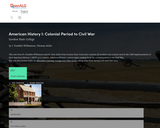
This text from Dr. Franklin Williamson and Dr. Tom Aiello from Gordon State University contains all modular text content used in the LMS implementation of their American History I (HIST 2111) courses. American History 1 covers topics ranging from the colonial period to the Civil War.
The text was created under an Affordable Learning Georgia G2C Pilot Grant, taking place from Spring 2018 until Fall 2019.
Table of Contents:
Chapter 1 - The Colonial South
Chapter 2 - The Colonial North
Chapter 3 - 18th Century Colonial Life
Chapter 4 - The French and Indian War
Chapter 5 - American Revolution, Part 1
Chapter 6 - American Revolution, Part 2
Chapter 7 - Articles of Confederation
Chapter 8 - Early Republic
Chapter 9 - Jeffersonian Era
Chapter 10 - Market Revolution
Chapter 11 - The North and 19th Century Thought
Chapter 12 - Slavery and Southern Life
Chapter 13 - Western Expansion
Chapter 14 - Sectional Conflict
Chapter 15 - American Civil War

This American Sign Language 101 OER is a Google Doc containing instructional videos of original design. The document also offers media content from ASL instructors and creators across the Web. All materials are meant as a supplement to ASL instruction. These resources are in no way intended to replace the breadth of knowledge acquired from taking an ASL course.

This American Sign Language 102 OER is a Google Doc containing instructional videos of original design. The document also offers media content from ASL instructors and creators across the Web. All materials are meant as a supplement to ASL instruction. These resources are in no way intended to replace the breadth of knowledge acquired from taking an ASL course.
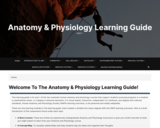
This learning guide is for part I of the two-semester human anatomy and physiology courses that support students pursuing programs in a medical or paramedical career, or a degree in physical education. It is cloud-based, interactive, independent of a textbook, and aligned with national standards, Human Anatomy and Physiology Society (HAPS) learning outcomes, to be perennial and widely adaptable.
There are nine learning modules in the learning guide. Each module is divided into topics aligned with the HAPS learning outcomes. Here is a brief introduction of the components found under each topic.
A Short Lecture: These are written by experienced undergraduate Anatomy and Physiology instructors to give you a brief overview of what you might expect to learn from your Anatomy and Physiology course.
A Concept Map: To visualize relationships and help students dig into ideas and organize their thoughts.
Key Points: A very quick overview of important concepts for the section.
Muddiest Points: Points that have caused confusion for students.
Interactive Exercises: These exercises can help students check their learning.
Students can use the learning guide as the following:
An overview before starting a topic in an Anatomy and Physiology Course
A guide to correct anatomical terminology that underlies the concepts of the course work
A place to review confusing concepts in regular course work
A place to find extra resources for study of concepts that are either understood or are still murky.
The development of this human anatomy and physiology learning guide is made possible with the support of the Virtual Library of Virginia (VIVA) Open Course Grants. It is created by a group of experienced faculty members at Northern Virginia Community College and reviewed by several members of the Human Anatomy and Physiology faculty at George Mason University.

Anatomy and Physiology 2 Laboratory Manual is a guide for anatomy and physiology laboratory exercises. It includes dissection guidance with detailed images; instructions for physiology experiments including foundational content; and gross anatomy study guides for six body systems. Videos and tutorial links provide additional support. including studies in the following areas:
Endocrine
Blood
Cardiovascular
Respiratory
Digestive
Urinary
Reproductive
Fetal Pig Dissection

This is a collection of mini lectures created by anthropologists and those in conversation with anthropology as supplimental material to assist college and university instructors who were made to shift their courses online because of COVID19.For more information, see here.To contribute, please create an OER author account and send your name and OER registered email to AnthropologyTeaching@gmail.com.
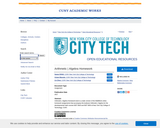
Arithmetic | Algebra Homework book is a static version of the WeBWork online homework assignments that accompany the textbook Arithmetic | Algebra for the developmental math courses MAT 0630 and MAT 0650 at New York City College of Technology, CUNY.
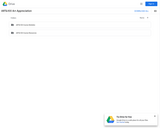
This is an exploration of visual art forms and their cultural connections for the student with little experience in the visual arts. The course includes a brief study of art history and in depth studies of the elements, media, and methods used in creative process and thought. Visual and performing arts are part of the Humanities: academic disciplines that study the human condition and, in addition to the arts, include languages, literature, law, history and religion. This course will teach students to develop a five-step system for understanding visual art in all forms based on description, analysis, meaning, context and judgment.Login: guest_oclPassword: ocl
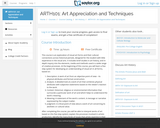
This course is an exploration of visual art forms and their cultural connections for the student with little experience in the visual arts. It includes a brief study of art history and in depth studies of the elements, media, and methods used in creative processes and thought. Upon successful completion of this course, students will be able to: interpret examples of visual art using a five-step critical process that includes description, analysis, context, meaning, and judgment; identify and describe the elements and principles of art; use analytical skills to connect formal attributes of art with their meaning and expression; explain the role and effect of the visual arts in societies, history, and other world cultures; articulate the political, social, cultural, and aesthetic themes and issues that artists examine in their work; identify the processes and materials involved in art and architectural production; utilize information to locate, evaluate, and communicate information about visual art in its various forms. Note that this course is an alternative to the Saylor FoundationĺÎĺ_ĺĚĺ_s ARTH101A and has been developed through a partnership with the Washington State Board for Community and Technical Colleges; the Saylor Foundation has modified some WSBCTC materials. This free course may be completed online at any time. (Art History 101B)
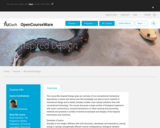
The course Bio-Inspired Design gives an overview of non-conventional mechanical approaches in nature and shows how this knowledge can lead to more creativity in mechanical design and to better (simpler, smaller, more robust) solutions than with conventional technology. The course discusses a large number of biological organisms with smart constructions, unusual mechanisms or clever sensing and processing methods and presents a number of technical examples and designs of bio-inspired instruments and machines.

Students perform a literature review on a biology topic, choose 2-3 papers published in scientific journals to discuss in their assignment, provide a final opinion on the topic, and some voluntarily present on their selected topic.
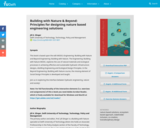
This book is based upon the edX MOOCs Engineering: Building with Nature and Beyond Engineering: Building with Nature. The Engineering: Building with Nature MOOC, explores the use of natural materials and ecological processes in achieving effective and sustainable hydraulic infrastructure designs, distilling Engineering and Ecological Design Principles. In the Beyond Engineering: Building with Nature course, the missing element of Social Design Principles is developed and taught.
Join us in exploring the interface between hydraulic engineering, nature and society!

This assignment was inspired by a group discussion by faculty who teach the First Year Seminar in Business (BTF101) during the 2018-19 Rebooting the FYS Seminar. BTF101 is a two-credit course that meets for a total of 3 hours. We were tasked with ways to improve course assignments aimed at strengthening students‰Ûª Global Learning Competency and Digital Communication Ability. The topic of sweatshops abroad is a proven way to introduce a Global Learning assignment with a business related topic. In order to deepen the students‰Ûª learning on the subject, the assignment tasks students with taking on the role of a Corporate Responsibility Officer (CRO) for Nike. In choosing to put students in this role, they are required to think of multiple perspectives as required by the Global Learning rubric.
The assignment includes several phases and culminates in a student-made video. The first phase of the assignment has students explore sweatshops through video, class discussion and a short writing assignment. The research material provided is intentionally focused on Nike‰Ûªs sweatshops so that students can narrow their focus to a particular instance of sweatshop usage in order to more readily formulate a company-specific response in their roles as CRO for Nike. Once the research phase is complete, students are asked to make a video explaining the issue to Nike in the role of a CRO. The students have to think about Nike‰Ûªs role as a business, the ethical issues of sweatshops and the ways in which they can address the issues. Students work on the assignment during the last third of the semester, and the assignment takes approximately 2 or 3 class hours. To make it manageable, I created an ePortfolio assignment template since students are required to post part of it on ePortfolio. The assignment is used as a final in my classes and worth 20 % of the overall grade. I grade it according to the College‰Ûªs Competency rubric, which is discussed earlier in the semester to ensure that students are familiar with the rubric. Finally, there are a variety of ways to use the existing materials. While the assignment is meant to address the Global Learning Competency and Digital Communication Ability, it also offers opportunities to support the Oral and Written Communication Abilities.

Students use the O*Net and Occupational Outlook Handbook websites to research careers.
Supplemental handout: Definition of Business Trends
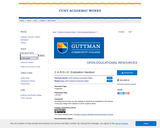
This guide is a helpful way of remembering the criteria you should consider when evaluating information: Currency, Authority, Relevance, Documentation, Information Type, and Objectivity. CARDIO.
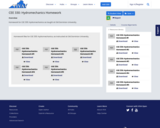
Homework for CEE 330: Hydromechanics as taught at Old Dominion University.